CMSX-4 Directional Solidification Casting Gas Turbine Blades
Introduction
Gas turbine blades face some of the harshest operational conditions in engineering—exposure to 1000°C+ temperatures, high centrifugal stress, and aggressive oxidation. To endure these extremes, blades must possess exceptional creep resistance, fatigue strength, and microstructural stability. CMSX-4, a second-generation nickel-based superalloy, was engineered specifically for such applications. When manufactured via directional solidification casting, CMSX-4 blades gain aligned columnar grains that extend creep life and prevent crack initiation.
Neway AeroTech delivers vacuum investment casting of CMSX-4 gas turbine blades using precise directional solidification techniques. Our solutions serve the aerospace, power generation, and defense sectors, where blade reliability and longevity are non-negotiable.
Core Technology of Directional Solidification for CMSX-4 Blades
Wax Pattern Fabrication High-precision wax patterns are molded to replicate airfoil geometry, cooling holes, root profiles, and shrouds within ±0.05 mm tolerance.
Ceramic Shell Mold Formation Shells are built with 6–10 mm thickness, combining strength and permeability to support controlled directional solidification.
Grain Selector Design A spiral selector or starter block is built into the mold to promote [001] columnar grain growth, eliminating transverse grain boundaries.
Vacuum Induction Melting CMSX-4 is melted under vacuum (≤10⁻³ Pa) at ~1450°C to minimize segregation and gas porosity.
Directional Solidification The mold is withdrawn vertically at 2–4 mm/min through a controlled thermal gradient to form aligned columnar grains along the stress axis.
Shell Removal and Surface Cleaning Shells are removed by blasting and chemical leaching while preserving cooling hole edges and complex airfoil features.
Hot Isostatic Pressing (HIP) HIP at 1180°C and 150 MPa eliminates shrinkage porosity and enhances fatigue resistance.
Heat Treatment Solution and aging treatments stabilize γ′ phase distribution for high-temperature mechanical performance.
CMSX-4 Material Properties for Directional Blades
Maximum Operating Temperature: 1100°C
Tensile Strength: ≥1100 MPa at 20°C
Creep Rupture Strength: ≥230 MPa at 982°C for 1000 hrs
Grain Structure: Columnar, [001] axis aligned (<2° deviation)
Gamma Prime Volume Fraction: ~70%
Oxidation Resistance: Excellent under continuous combustion gas exposure
Case Study: CMSX-4 Directional Cast Blades for HPT
Project Background
Neway AeroTech produced high-pressure turbine (HPT) blades using CMSX-4 for a next-gen 90 MW gas turbine platform. The blades were required to operate above 1050°C continuously, with minimal elongation, no creep deformation, and stable performance across 20,000+ cycles.
Applications
Aerospace HPT Blades (e.g., F119, LEAP-X): For jet engines requiring consistent high-temperature operation with minimal fatigue.
Industrial Power Turbines (e.g., GE Frame 7EA, Siemens SGT): HPT blades operating in base-load and peaking service with long maintenance cycles.
Marine Propulsion Turbines (e.g., LM2500+): Blades requiring oxidation and corrosion resistance under salt-laden hot gas conditions.
Manufacturing Solution for Directional CMSX-4 Blades
Wax Assembly and Mold Engineering Gating systems and spiral selectors are optimized using CFD simulation to ensure clean metal flow and stable solidification.
Directional Casting in Vacuum Environment Molds are cast in vacuum and withdrawn from the heat zone using controlled parameters to produce fully aligned columnar grains.
Post-Casting HIP and Heat Treatment HIP removes microvoids. Heat treatment optimizes γ′ phase for creep and fatigue resistance.
CNC Machining and EDM Finalization Cooling slots, bolt holes, and tip geometries are finished via CNC machining and EDM.
NDT and Dimensional Inspection Components undergo X-ray, CMM, and EBSD inspection to confirm structural integrity and grain alignment.
Challenges in Manufacturing CMSX-4 Directional Blades
Preventing stray grain formation in thin trailing edges and shrouds
Maintaining withdrawal rate for consistent grain structure in large blades
Ensuring creep properties after full thermal processing
Achieving dimensional accuracy on cooling slot exit profiles
Results and Verification
[001] columnar grain orientation confirmed via EBSD (<2° deviation)
Shrinkage porosity eliminated after HIP, NDT-compliant
Creep strength >230 MPa at 982°C across all test bars
Final blade dimensions held within ±0.03 mm
100% batch acceptance for X-ray and ultrasonic inspections
FAQs
What makes CMSX-4 ideal for directional turbine blade casting?
How does directional casting improve creep life over equiaxed casting?
What industries commonly use CMSX-4 directional blades?
What is the difference between directional and single crystal blades?
How are grain orientation and casting integrity verified?

